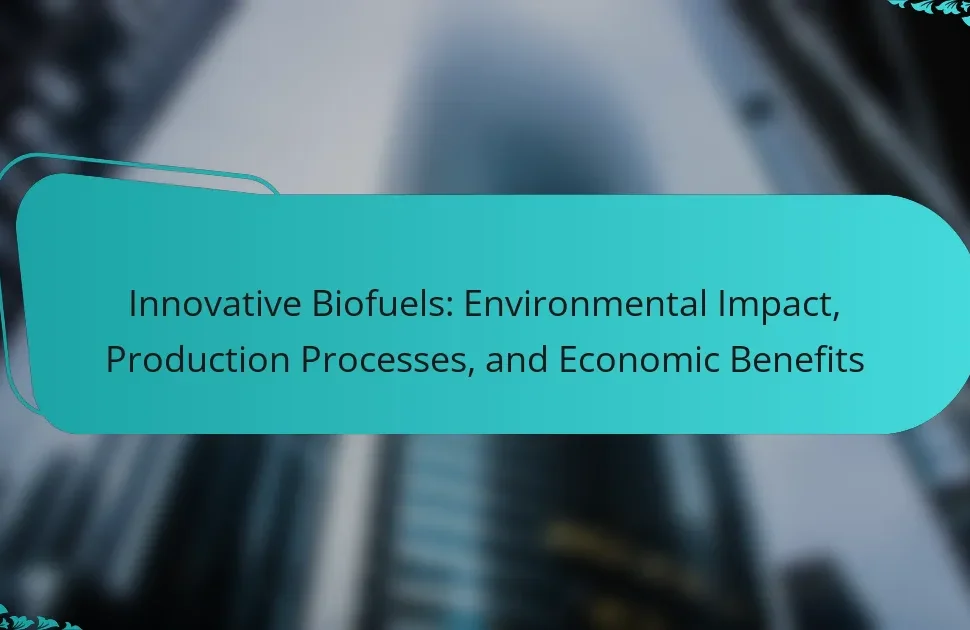
What are Alternative Fuels?
Alternative fuels are energy sources that serve as substitutes for traditional fossil fuels. These fuels include biofuels, hydrogen, electricity, and natural gas. They are designed to reduce greenhouse gas emissions and dependence on petroleum. For example, biofuels are derived from organic materials, while hydrogen can be produced from water and renewable energy sources. The use of alternative fuels can lead to cleaner air and lower carbon footprints. According to the U.S. Department of Energy, alternative fuels can significantly decrease greenhouse gas emissions compared to conventional fuels.
How do Alternative Fuels differ from traditional fuels?
Alternative fuels differ from traditional fuels primarily in their sources and environmental impact. Traditional fuels, such as gasoline and diesel, are derived from fossil fuels. These fuels release significant greenhouse gases when burned. In contrast, alternative fuels include biofuels, hydrogen, and electricity. Many alternative fuels produce fewer emissions or can be renewable. For example, biofuels can be produced from plant materials, reducing reliance on fossil fuels. Hydrogen can be generated from water using renewable energy, leading to zero emissions at the point of use. The U.S. Department of Energy reports that using alternative fuels can significantly lower carbon footprints compared to traditional fuels.
What are the key characteristics of Alternative Fuels?
Alternative fuels are energy sources that provide alternatives to traditional fossil fuels. They are typically renewable or less polluting than conventional fuels. Common types include biofuels, hydrogen, electricity, and natural gas. Alternative fuels often have lower greenhouse gas emissions, contributing to environmental sustainability. Many alternative fuels are derived from organic materials, making them renewable. They can be used in various applications, including transportation and electricity generation. The adoption of alternative fuels is driven by policies promoting cleaner energy. In 2020, the global biofuel market was valued at approximately $139 billion, indicating significant market interest.
Why are Alternative Fuels considered environmentally friendly?
Alternative fuels are considered environmentally friendly because they produce lower greenhouse gas emissions compared to traditional fossil fuels. For instance, biofuels can reduce carbon dioxide emissions by up to 80% when sourced sustainably. Electric vehicles using renewable energy emit no tailpipe pollutants. Hydrogen fuel cells produce only water vapor as a byproduct. Additionally, alternative fuels often utilize waste materials, reducing landfill use. The use of these fuels can also decrease dependence on finite fossil fuel resources. Studies show that transitioning to alternative fuels can significantly improve air quality in urban areas. Overall, their adoption contributes to a more sustainable and cleaner environment.
What types of Alternative Fuels are available?
Alternative fuels include biodiesel, ethanol, hydrogen, natural gas, and electricity. Biodiesel is derived from vegetable oils or animal fats. Ethanol is often made from corn or sugarcane. Hydrogen fuel cells produce electricity through a chemical reaction. Natural gas is primarily methane and can be used in compressed or liquefied forms. Electricity is used in battery electric vehicles. Each alternative fuel offers different benefits, such as reduced emissions or renewable sources. The adoption of these fuels varies based on infrastructure and technology advancements.
What are the most common types of Alternative Fuels?
The most common types of alternative fuels include ethanol, biodiesel, hydrogen, propane, and electricity. Ethanol is often produced from corn or sugarcane and is used in various gasoline blends. Biodiesel is derived from vegetable oils or animal fats and can replace diesel fuel. Hydrogen fuel cells generate electricity through a chemical reaction and emit only water as a byproduct. Propane is a byproduct of natural gas processing and crude oil refining and is commonly used for heating and vehicles. Electricity, particularly from renewable sources, powers electric vehicles and reduces greenhouse gas emissions. These alternative fuels contribute to reducing reliance on fossil fuels and lowering environmental impact.
How do biofuels compare to hydrogen fuels?
Biofuels and hydrogen fuels differ significantly in their composition and application. Biofuels are derived from organic materials like plants and waste, while hydrogen fuels are produced from hydrogen gas. Biofuels can be used directly in existing internal combustion engines. Hydrogen fuels require fuel cells or specialized engines for use.
In terms of emissions, biofuels can produce lower greenhouse gases compared to fossil fuels but still emit carbon dioxide. Hydrogen fuels, when used in fuel cells, emit only water vapor, making them cleaner.
Biofuels are generally easier to produce and implement due to existing infrastructure. Hydrogen fuels face challenges in storage and distribution due to their low energy density.
Market adoption varies; biofuels are more established in transportation. Hydrogen fuels are gaining traction in sectors like heavy-duty transport and industrial applications.
What are the benefits of using Alternative Fuels?
Alternative fuels offer several benefits, including reduced greenhouse gas emissions. They often produce lower levels of air pollutants compared to conventional fuels. For instance, biofuels can decrease carbon dioxide emissions by up to 80% compared to gasoline. Alternative fuels can enhance energy security by reducing dependence on fossil fuels. They can also promote economic growth by creating jobs in renewable energy sectors. Furthermore, many alternative fuels are derived from domestically sourced materials, which can stabilize local economies. The use of alternative fuels can lead to improved public health due to better air quality. Finally, they often have the potential for lower operating costs over time, especially as technology advances.
How do Alternative Fuels impact greenhouse gas emissions?
Alternative fuels significantly reduce greenhouse gas emissions compared to traditional fossil fuels. They often produce lower carbon dioxide and other harmful emissions during combustion. For instance, biofuels can emit up to 80% less carbon dioxide than gasoline. Electric vehicles powered by renewable energy sources can lead to near-zero emissions. Hydrogen fuel cells also produce only water vapor as a byproduct. Additionally, the lifecycle emissions of alternative fuels are generally lower when considering production and distribution. The U.S. Environmental Protection Agency states that transitioning to alternative fuels can significantly mitigate climate change effects.
What economic advantages do Alternative Fuels offer?
Alternative fuels offer significant economic advantages, including reduced dependence on fossil fuels. They often lead to lower fuel costs for consumers and businesses. For example, biofuels can be produced locally, which stimulates local economies and creates jobs. Additionally, alternative fuels can reduce greenhouse gas emissions, leading to lower environmental cleanup costs. The U.S. Department of Energy reports that investments in alternative fuel infrastructure can yield substantial returns. Furthermore, government incentives for alternative fuel usage can enhance economic benefits. Overall, these factors contribute to a more sustainable and resilient economy.
What performance metrics are used to evaluate Alternative Fuels?
Performance metrics used to evaluate alternative fuels include energy content, emissions, and cost-effectiveness. Energy content measures the amount of energy produced per unit of fuel. Emissions assess the environmental impact, including greenhouse gases and pollutants released during combustion. Cost-effectiveness evaluates the economic viability of the fuel compared to conventional options. Other metrics may include fuel efficiency, availability, and infrastructure compatibility. These metrics provide a comprehensive framework for assessing the viability of alternative fuels in various applications.
How is fuel efficiency measured for Alternative Fuels?
Fuel efficiency for alternative fuels is measured using miles per gallon equivalent (MPGe). MPGe quantifies how far a vehicle can travel on the energy equivalent of one gallon of gasoline. This measurement allows for a standardized comparison between different fuel types. Alternative fuels include electricity, hydrogen, and biofuels, each with distinct energy content. For example, electric vehicles convert electricity to miles driven, while hydrogen fuel cells convert hydrogen into electricity. Regulatory agencies like the Environmental Protection Agency (EPA) provide guidelines for calculating MPGe. These calculations consider the energy density of each fuel type. Accurate MPGe values help consumers assess fuel efficiency across various alternative fuel vehicles.
What safety standards apply to Alternative Fuels?
Safety standards for alternative fuels include regulations set by organizations like the National Fire Protection Association (NFPA) and the American National Standards Institute (ANSI). These standards ensure safe handling, storage, and use of alternative fuels. Specific guidelines address risks associated with flammable and hazardous materials. The Department of Transportation (DOT) also establishes standards for the transportation of alternative fuels. Compliance with these standards is crucial for preventing accidents and ensuring public safety. Various fuel types, such as hydrogen and biodiesel, have unique safety requirements outlined in these regulations.

How is the market adoption of Alternative Fuels progressing?
The market adoption of alternative fuels is steadily increasing. This growth is driven by rising environmental concerns and government regulations. In 2022, global sales of electric vehicles reached over 10 million units, a 55% increase from 2021. Additionally, biofuels accounted for approximately 3% of the total transportation fuel market in the same year. Hydrogen fuel cell technology is also gaining traction, with investments exceeding $1 billion in 2023. These trends indicate a significant shift toward cleaner energy sources in the transportation sector.
What factors influence the adoption of Alternative Fuels?
The adoption of alternative fuels is influenced by several key factors. These factors include economic viability, government policies, and technological advancements. Economic viability refers to the cost-effectiveness of alternative fuels compared to traditional fuels. A study by the National Renewable Energy Laboratory shows that price competitiveness is crucial for consumer acceptance. Government policies can incentivize adoption through subsidies or tax breaks. Research published in the Journal of Cleaner Production highlights that supportive regulations significantly boost market [censured]. Technological advancements improve fuel efficiency and infrastructure, making alternative fuels more accessible. The International Energy Agency reports that advancements in battery technology have increased the adoption of electric vehicles. Public awareness and environmental concerns also play a role in driving the shift towards alternative fuels. A survey by the Pew Research Center indicates that consumers are increasingly motivated by sustainability.
How do government policies affect the use of Alternative Fuels?
Government policies significantly influence the use of alternative fuels. They can promote or hinder the adoption of these fuels through regulations, incentives, and funding. For example, tax credits for biofuels encourage production and consumption. The Renewable Fuel Standard mandates a certain volume of renewable fuel usage, driving market demand. Conversely, stringent regulations on emissions can push industries to seek alternative fuel options. According to the U.S. Department of Energy, government investments in research and development have accelerated advancements in alternative fuel technologies. Additionally, subsidies for electric vehicles have increased their market share, showcasing the impact of supportive policies. Overall, government actions shape the landscape for alternative fuels, affecting both supply and demand.
What role do consumer preferences play in market adoption?
Consumer preferences significantly influence market adoption of alternative fuels. These preferences dictate the demand for specific fuel types based on perceived benefits. Factors such as environmental impact, cost, and convenience shape consumer choices. For instance, studies show that consumers are more likely to adopt fuels that align with their values, such as sustainability. According to a 2021 report by the International Energy Agency, consumer interest in electric vehicles surged as awareness of climate change grew. This shift demonstrates how consumer preferences can drive market trends. Ultimately, understanding these preferences is crucial for companies aiming to introduce new alternative fuels successfully.
What challenges are faced in the market adoption of Alternative Fuels?
The market adoption of alternative fuels faces several challenges. High production costs hinder widespread use. Limited infrastructure for refueling stations restricts accessibility. Consumer awareness and acceptance remain low for many alternative fuel options. Regulatory hurdles can delay the implementation of new technologies. Additionally, competition from established fossil fuels poses a significant barrier. Market volatility can affect investment in alternative fuel projects. These challenges collectively slow the transition to alternative fuels in the transportation sector.
How does infrastructure impact the use of Alternative Fuels?
Infrastructure significantly impacts the use of alternative fuels by determining availability and accessibility. Well-developed infrastructure, such as refueling stations, facilitates the adoption of alternative fuels like electric, hydrogen, and biofuels. For example, a robust network of electric vehicle charging stations encourages consumers to purchase electric vehicles. Conversely, inadequate infrastructure can hinder market growth and consumer acceptance. The U.S. Department of Energy reported that regions with extensive alternative fuel infrastructure see a higher percentage of alternative fuel vehicles on the road. Therefore, the presence and quality of infrastructure directly influence the market [censured] of alternative fuels.
What technological barriers exist for Alternative Fuels?
Technological barriers for alternative fuels include limited infrastructure, high production costs, and energy density issues. Infrastructure for distribution and refueling is often underdeveloped. This lack of infrastructure hampers widespread adoption. High production costs make alternative fuels less competitive with traditional fuels. For example, biofuels can be costly to produce compared to gasoline. Energy density of some alternative fuels is lower, affecting vehicle range and performance. Hydrogen fuel cells, while promising, face challenges in storage and transport. These barriers hinder the transition to alternative fuels in the market.
What trends are shaping the future of Alternative Fuels?
The future of alternative fuels is shaped by several key trends. First, there is a growing emphasis on sustainability. Governments and organizations are increasingly prioritizing eco-friendly fuel sources. Second, technological advancements are enhancing fuel efficiency. Innovations in production processes are making alternative fuels more viable. Third, the rise of electric vehicles is influencing fuel market dynamics. Electric mobility is leading to greater investments in battery technologies. Fourth, policy changes are driving market adoption. Regulations are encouraging the use of cleaner fuels. Finally, consumer awareness is increasing. More individuals are seeking sustainable energy options. These trends indicate a significant shift towards alternative fuels in the coming years.
How is innovation driving the development of Alternative Fuels?
Innovation is driving the development of alternative fuels by introducing new technologies and processes. These advancements enhance efficiency and reduce costs. For example, breakthroughs in biofuel production are increasing yield from feedstocks. Innovations in hydrogen fuel cells are improving energy density and reducing weight. Additionally, advancements in battery technology are making electric vehicles more viable. Research from the International Energy Agency indicates that alternative fuel technologies can significantly lower greenhouse gas emissions. As a result, innovation is crucial for the widespread adoption of cleaner energy sources.
What are the forecasts for the Alternative Fuels market?
The forecasts for the Alternative Fuels market indicate significant growth. The market is expected to reach approximately $300 billion by 2025. This growth is driven by increasing government regulations on emissions and rising fuel prices. Additionally, advancements in technology are making alternative fuels more accessible and efficient. Reports suggest a compound annual growth rate (CAGR) of around 10% during this period. The demand for cleaner energy sources is also contributing to this upward trend. Key players in the market include biofuels, hydrogen, and electric vehicles. These segments are projected to expand rapidly as consumer preferences shift towards sustainability.
What best practices can enhance the adoption of Alternative Fuels?
To enhance the adoption of alternative fuels, implementing comprehensive education and awareness programs is essential. These programs should inform consumers and businesses about the benefits and availability of alternative fuels. Financial incentives, such as tax credits and subsidies, can encourage investment in alternative fuel technologies. Infrastructure development, including refueling stations and distribution networks, is crucial for accessibility. Collaborations between government, industry, and research institutions can drive innovation and reduce costs. Policies promoting renewable energy use can create a favorable regulatory environment. Research indicates that countries with supportive policies see higher adoption rates of alternative fuels. For example, Norway’s electric vehicle incentives led to over 54% of new car sales being electric in 2020.
How can consumers effectively transition to using Alternative Fuels?
Consumers can effectively transition to using alternative fuels by researching available options and understanding their benefits. They should evaluate different types of alternative fuels, such as biofuels, electricity, and hydrogen. Understanding the infrastructure for these fuels is crucial. Consumers should identify local refueling stations or charging points. Financial incentives can help ease the transition, so exploring government rebates is beneficial. Additionally, consumers should consider the environmental impact of their fuel choice. Engaging with community programs can provide support and information. According to the U.S. Department of Energy, alternative fuels can reduce greenhouse gas emissions significantly.
What role do businesses play in promoting Alternative Fuels?
Businesses play a crucial role in promoting alternative fuels. They invest in research and development to create more efficient fuel technologies. Many companies implement alternative fuel programs to reduce carbon emissions. They also establish partnerships with governments to support infrastructure development. Businesses often educate consumers about the benefits of alternative fuels. They contribute to market demand through production and distribution. According to the U.S. Department of Energy, private sector investments in alternative fuels have increased significantly in recent years. This investment drives innovation and makes alternative fuels more accessible to consumers.
Alternative fuels are energy sources that replace traditional fossil fuels, including biofuels, hydrogen, electricity, and natural gas, aimed at reducing greenhouse gas emissions and reliance on petroleum. This article provides a comprehensive overview of alternative fuels, detailing their types, key characteristics, and environmental benefits. It explores the differences between alternative and traditional fuels, examines performance metrics for evaluating their efficacy, and discusses market adoption trends influenced by government policies and consumer preferences. Additionally, challenges such as infrastructure development and technological barriers are addressed, alongside forecasts for the future growth of the alternative fuels market.




